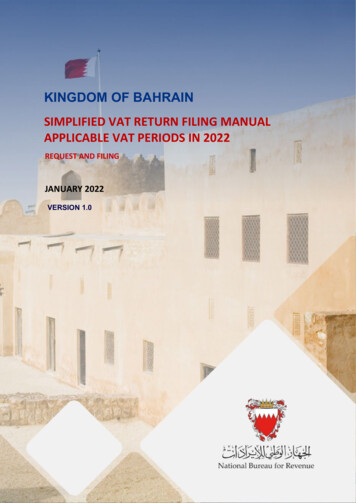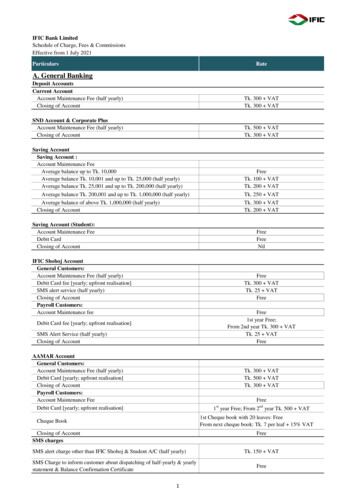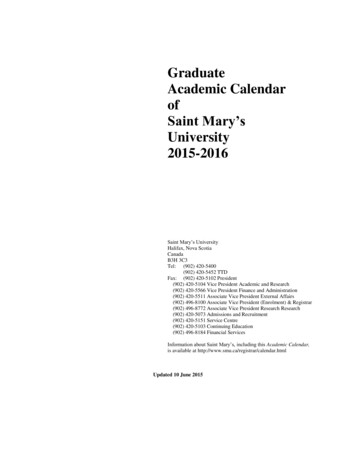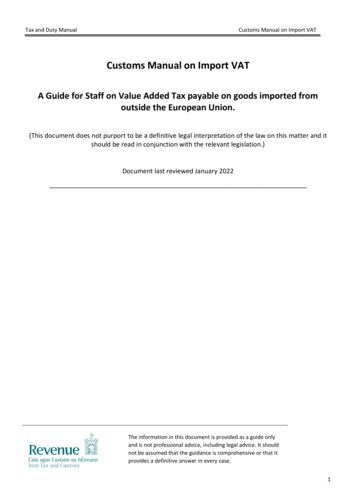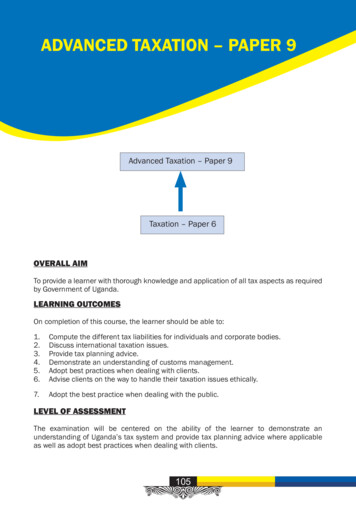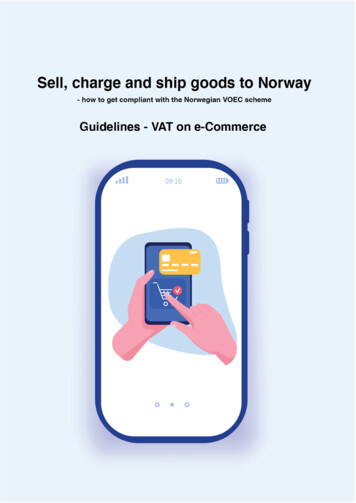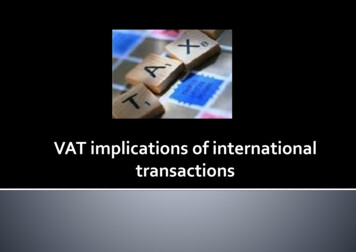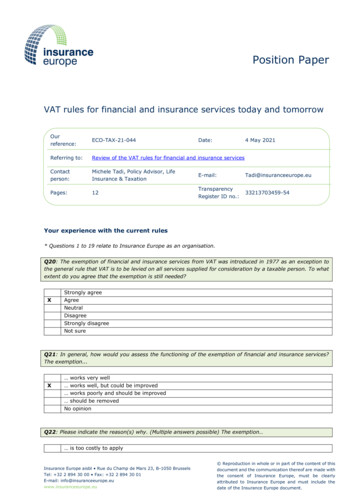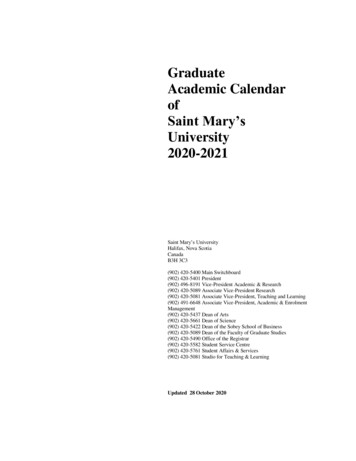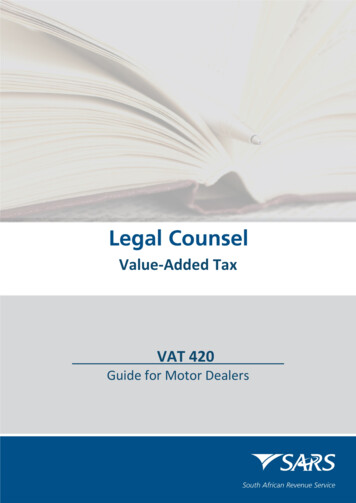
Transcription
Value-Added TaxVAT 420Guide for Motor Dealers
VAT 420 – Guide for Motor DealersPrefacePrefaceThis guide concerns the application of the value-added tax (VAT) legislation in respect ofvendors that supply motor cars and other vehicles (motor dealers). Although fairlycomprehensive, the guide does not deal with all the legal detail associated with VAT and isnot intended for legal reference. Technical and legal terminology has also been avoidedwherever possible. For details in respect of the general operation of VAT, see the VAT 404 –Guide for Vendors which is available on the South African Revenue Service (SARS) website.All references to “the VAT Act” are to the Value-Added Tax Act 89 of 1991, and referencesto “sections” are to sections in the VAT Act, unless the context indicates otherwise. Allreferences to “the TA Act” are to the Tax Administration Act 28 of 2011.The terms “Republic”, “South Africa” or the abbreviation “RSA”, are used interchangeably inthis document as a reference to the sovereign territory of the Republic of South Africa, as setout in the definition of “Republic” in section 1(1). Similarly, the terms “motor vehicle” or“vehicle” are also used as a reference to all types of vehicles which may be supplied bymotor dealers. The term “motor car” is, however, used in certain instances where it isnecessary to refer to this specifically defined term. A number of specific terms usedthroughout the guide are defined in the VAT Act. These terms and others are listed in theGlossary in a simplified form.The information in this guide is based on the VAT Act (as amended) and the TA Act (asamended) as at the time of publishing. It includes the amendments contained in the TaxationLaws Amendment Act 25 of 2015 and the Tax Administration Laws Amendment Act 23 of2015 which were promulgated on 8 January 2016 as per GG 39588 and GG 39586respectively.The reader is referred specifically to the following documents for more detailed informationon specific topics dealt with in this guide: Interpretation Note 82 (IN 82) dealing with the definition of “motor car” and thededuction of input tax on acquisition of a “motor car”; Binding General Ruling (VAT) 12 (BGR 12) regarding over-allowances which isreproduced in Annexure B; Interpretation Note 30 (Issue 3) (IN 30) for the requirements regarding thedocumentary proof required to substantiate the application of the zero rate in respectof direct exports; and The Export Regulation that was gazetted on 2 May 2014 (as per GG 37580)regarding indirect exports.There are also various other guides available on the SARS website or to the VAT 404 –Guide for Vendors which may be referred to for more information relating to the variouspublications.This guide is not an “official publication” as defined in section 1 of the TA Act andaccordingly does not create a practice generally prevailing under section 5 of that Act.The previous edition of this guide is withdrawn with effect from 28 September 2016.All guides, interpretation notes, binding general rulings, forms, returns and tables referred toin this Note are available on the SARS website.i
VAT 420 – Guide for Motor DealersPrefaceShould there be any aspects relating to VAT which are not clear or not dealt with in thisguide, or should you require further information or a specific ruling on a legal issue, youmay – contact your local SARS branch; visit the SARS website at www.sars.gov.za; contact your own tax advisors; contact the SARS National Call Centre – if calling locally, on 0800 00 7277; or if calling from abroad, on 27 11 602 2093; submit legal interpretative queries on the TA Act by email to TAAInfo@sars.gov.za;or submit a ruling application to SARS headed “Application for a VAT Class Ruling” or“Application for a VAT Ruling” together with the VAT301 form by email toVATRulings@sars.gov.za or by facsimile on 27 86 540 9390.Comments regarding this guide may be e-mailed to policycomments@sars.gov.zaPrepared byLegal CounselSouth African Revenue Service28 September 2016ii
VAT 420 – Guide for Motor DealersContentsContentsPreface . iChapter 1 Introduction. 11.11.21.3Approach of the guide . 1General VAT principles . 2Tax administration . 2Chapter 2 Definitions and concepts . ent . 3Consideration . 3Enterprise . 4Exported . 4Floor plan . 5Goods and second-hand goods . 5Input tax and “notional” input tax . 5Instalment credit agreement and rental agreement . 7Motor car . 7Output tax . 8Over-allowance . 8Sale, supply and taxable supply . 8Services . 9VAT registration . 9Chapter 3 Types of supplies . 83.93.103.113.123.133.14Introduction . 11Supply of motor vehicles . 11Outright sales . 11Instalment Credit Agreements . 12Floor plan agreements . 13Consignment stock. 15Sundry supplies made by motor dealers. 15Referral fees . 15The supply of accessories or parts . 16Sponsorship . 16Rental agreements and discounted rental agreements . 19Discounted instalment credit agreements . 19Deemed supplies in respect of indemnity payments . 20Licensing and registration . 21Service and maintenance plans . 22Warranty services . 22Fringe benefits . 23Repossession and surrender of goods . 24Auction sales . 25Chapter 4 Exports . 6Introduction . 28Direct exports . 28New goods . 28Second-hand goods . 31Indirect exports . 33Part One of the Export Regulation . 33Part Two – Section A of the Export Regulation – New goods . 35Part Two – Section A of the Export Regulation – Second-hand goods . 36Part Two – Section B of the Export Regulation – New goods . 36Part Three . 37General. 38Chapter 5 Imports . 39iii
VAT 420 – Guide for Motor Dealers5.15.25.35.45.5ContentsIntroduction . 39Importation of goods . 39Goods temporarily imported for servicing or repairs . 39Trans-shipment of goods . 40Non-resident manufacturer warranties . 40Chapter 6 Input tax. 426.16.26.36.46.56.66.76.86.96.10General rules . 42Dealer stock . 42Second-hand goods . 42Importation of motor vehicles . 44Insurance . 45Commissions paid . 45Repossession and surrender of goods . 45Floor plans . 46General overheads . 46Denial of input tax . 46Glossary . 47Annexure A – Form VAT264 . 52Annexure B – Binding General Ruling (VAT): No. 12 (Issue 2) . 53Contact details . 56iv
VAT 420 – Guide for Motor DealersChapter 1Chapter 1Introduction1.1Approach of the guideFor the most part, the general VAT principles as set out in the VAT 404 – Guide for Vendorswill apply to motor dealers. The information in this guide should therefore be read togetherwith the VAT 404 – Guide for Vendors. This guide expands on the application of the normalVAT principles with regard to specific types of transactions which are of interest to motordealers and the motor industry in general.The approach to the topic and the layout of the material in this guide is set out as follows:Chapter 1 – This chapter sketches the general VAT principles concerning the VAT treatmentof the supply of motor vehicles in the Republic. An important aspect in this regard is that, asa general rule, a vendor may not deduct input tax on the acquisition of a “motor car” asdefined in the VAT Act. However, this rule does not apply to a vendor that supplies motorcars for a consideration in the ordinary course of conducting an enterprise. A brief overviewis also provided on the basic principles of VAT and how it applies to motor dealers.Chapter 2 – This chapter introduces the reader to some of the more important concepts anddefinitions contained in the VAT Act. It also deals with terminology used in the motor industrywhich is relevant for the purposes of certain topics to be discussed in later chapters.Chapter 3 – In this chapter the various types of supplies which are made by motor dealersare discussed in some detail. In particular, the focus is on the nature of the supplies andwhether output tax must be declared by the motor dealer, or by some other vendor in thecase where the motor dealer has acted as agent.Chapter 4 – It is important for motor dealers that are involved in exporting vehicles to draw adistinction between direct and indirect exports, as well as new and second-hand motorvehicles exported, as the VAT treatment differs. This chapter therefore discusses the rulesfor applying the zero rate of VAT to different types of exports, the applicable documentationwhich a vendor is required to hold to justify the charging of VAT at the zero rate on exports,and the possible VAT adjustments which may be required when the export documentation isnot received timeously.Chapter 5 – The different circumstances under which goods are imported into the Republicare discussed. As the normal rules in this regard are discussed in the VAT 404 – Guide forVendors, this chapter focuses on specific types of imports which may apply to motor dealers.For example, the temporary import of vehicles for the purpose of servicing or repair, transshipment of vehicles destined for export countries, and certain aspects concerningwarranties.Chapter 6 – This chapter focuses on the different types of supplies acquired or goodsimported by motor dealers in the course of conducting an enterprise, and sets out the ruleswith regard to the deduction of input tax in that regard.1
VAT 420 – Guide for Motor Dealers1.2Chapter 1General VAT principlesVAT is an indirect tax levied on the supply of goods or services in the Republic by a vendor.It is also levied on the importation of goods into the Republic, and in some cases, on theimportation of services. The aim of VAT is to raise revenue for the government by taxingfinal consumption of goods and services in the Republic. Accordingly, supplies and importsof goods or services consumed in the Republic are generally taxable for VAT purposes.A person that continuously or regularly supplies motor vehicles (for example, a motor dealer)will be required to register as a vendor if the compulsory VAT registration threshold ofR1 million in taxable supplies in any consecutive 12-month period is exceeded. Most motordealers will therefore be liable to register as VAT vendors. A motor dealer that is registered(or required to be registered) for VAT must levy VAT on all taxable supplies made in thecourse or furtherance of its enterprise. In addition, a motor dealer is required to know theapplicable rate of VAT that must be imposed on such supplies (that is, 14% or 0%).VAT charged to customers is called “output tax”, while the VAT incurred on vehiclepurchases and other business expenses that are incurred wholly or partly for purposes ofmaking taxable supplies is known as “input tax”. The output tax less the input tax in a taxperiod results in the net amount of VAT payable by or refundable to the vendor. As a generalrule, input tax is specifically denied in respect of certain business expenses, for example,expenses in connection with entertainment and the acquisition of motor cars.The term “motor dealer” is not defined in the VAT Act. For the purposes of this guide, theterm “motor dealer” is used with reference to a vendor that, in the ordinary course ofconducting an enterprise activity, 1 acquires motor cars exclusively for the purpose of resaleor rental to third parties. The term is not limited to persons who are formally set up in thetrading style of a motor dealership. The term can therefore include reference to motormanufacturers, car rental enterprises, financiers that supply motor vehicles under instalmentcredit agreement or any other person that supplies motor vehicles in the course orfurtherance of conducting an enterprise.See the VAT 404 – Guide for Vendors for more details regarding the general principles.1.3Tax administrationThe TA Act was promulgated on 4 July 2012 and came into effect on 1 October 2012, exceptfor the provisions set out in Schedule 1 to the TA Act relating to interest as perProclamation 51 dated 14 September 2012 (GG 35687).The TA Act regulates the administration of all the tax Acts. The VAT Act must therefore beread together with the provisions of the TA Act (for example both the TA Act and VAT Actcontain requirements in respect of record keeping which must be complied with). This guidemust therefore be read in the context of the TA Act and any public notices or proclamationsissued in connection with any general tax administration matter.See the VAT 404 – Guide for Vendors for more details regarding the interaction between theVAT Act and the TA Act.Further general information regarding the application of the TA Act can be obtained from theTax Administration webpage on the SARS website.1See 2.3.2
VAT 420 – Guide for Motor DealersChapter 2Chapter 2Definitions and concepts2.1AgentAn agent is a person that acts under a contractual arrangement in terms of which oneperson (the agent) is authorised and required by another person (the principal) to contract orto negotiate a contract with a third person, on the latter’s behalf. The agent, in representingthe principal, creates, alters or discharges legal obligations of a contractual nature betweenthe principal and the third party. The agent therefore provides a service to the principal andnormally charges a fee (generally referred to as “commission” or an “agency fee”) and doesnot acquire ownership of the goods and/or services supplied to or by the principal.This agent/principal relationship may be expressly construed from the wording of a writtenagreement or contract concluded between the parties. If there is no written agreement orcontract, the onus is on the person who purports to be the agent (who seeks to bind theprincipal in a contract) to demonstrate that an agency agreement exists with another personwho is the principal for the purposes of the supply.In essence, where an agent/principal relationship exists, the principal is ultimatelyresponsible for the commercial risks associated with a transaction, and the agent is tradingfor the principal’s account. The agent is appointed by, and takes instruction from, theprincipal regarding the facilitation of transactions as per the principal’s requirements andgenerally charges a fee or earns a commission for that service.Before determining the VAT consequences of a transaction, it is necessary to establish therelationship between the parties. This is to determine if the vendor is acting as an agent onbehalf of another person or as principal. If an agent makes a supply on behalf of theprincipal, it is the principal who must account for VAT on the supply. 2 Likewise, if a supply ismade to an agent on behalf of the principal, it is the principal who may deduct the input tax,provided all the conditions for deducting input tax are met. 3Section 54 contains special provisions to deal with the VAT consequences arising from anagency relationship. (See the VAT 404 – Guide for Vendors for more detail.)2.2ConsiderationThe term “consideration” generally means the total amount of money (including VAT)received for a supply of goods or services. “Consideration” is widely defined to include anyform of payment and any act or forbearance, whether or not voluntary, for the inducement ofa supply of goods or services. In the case that the consideration is not in money (forexample, in the case of barter transactions), the consideration is the open market value ofthe goods or services (including VAT) received for making the taxable supply.The term “consideration” excludes –23 any donation made to an association not for gain; and a deposit which is lodged to secure a future supply of goods or services, which hasnot yet been applied as payment (for example, a security deposit held in trust untilthe time of supply is triggered), or which has not yet been forfeited.Section 54(1).Section 54(2).3
VAT 420 – Guide for Motor DealersChapter 2The value of a supply or amount of the consideration for VAT purposes for different types ofsupplies of goods or services is determined in section 10. Since consideration comprises thevalue of the taxable supply and the VAT, the following formulae can be derived:Consideration Value VATorVAT Consideration – Value2.3EnterpriseThe term “enterprise” is the starting point in determining whether a person is liable to beregistered for VAT purposes in the Republic. A person is generally considered to be carryingon an “enterprise” if all of the following requirements are met:2.4 An enterprise or activity must be carried on continuously or regularly by a person inthe Republic or partly in the Republic. In the course or furtherance of carrying on the enterprise or activity, goods orservices must be supplied to another person. There must be a consideration payable for the goods or services supplied.ExportedThe term “exported” in the context of this guide, refers to a situation when motor vehicles(being movable goods) are supplied under a sale or instalment credit agreement (ICA) by aSouth African motor dealer (vendor) and subsequently removed from the Republic andimported into an export country.In cases where the motor dealer consigns or delivers the motor vehicle(s) to a customer inan export country, it is referred to as a “direct export” which is subject to VAT at the zerorate. 4 The zero rate applies only if the necessary documentary proof is obtained andretained to prove that the vehicle was exported within the prescribed period. In the case of adirect export, the supplier is in control of the movement of the goods and is responsible forthe delivery thereof at a place in an export country.On the other hand, an “indirect export” is when the customer takes delivery of the goods andis responsible for the removal (exportation) of the goods from the Republic. The motor dealersupplying the goods in this case will not be in control of the movement of the goods after thesale has been concluded and cannot be certain that the goods will be exported by thecustomer.As a general rule, indirect exports are subject to VAT at the standard rate, but if the goodsare subsequently exported from the Republic, the customer may apply to the VAT RefundAdministrator (Pty) Ltd (VRA) 5 for the VAT charged on the supply to be refunded. In certaininstances, a motor dealer may elect to apply the zero rate in respect of an indirect export,provided all the requirements in the Export Regulation 6 are met. In these cases, the motordealer will bear the risk of ensuring that the required documentation will be received to justifythe application of the zero rate. (See Chapter 4 for more details.)456See paragraph (a) of the definition of “exported” in section 1(1), read with sections 11(1)(a)(i) and11(3). See also IN 30 for the requirements regarding documentary proof of export.A private company appointed by SARS to administer the VAT refund mechanism.The Export Regulation was gazetted on 2 May 2014 (as per GG 37580).4
VAT 420 – Guide for Motor Dealers2.5Chapter 2Floor planA “floor plan” is a generic term used to refer to the financing of motor vehicles that are heldin stock by a motor dealer before they are sold. The motor vehicles could be in transit, in aspecial storage facility (for example, a special storage warehouse), or on the motor dealer'sshowroom floor. A floor plan is a standing arrangement, involving various parties and apredetermined combination of transactions and conditions primarily aimed at funding assetsduring the period between manufacture, export or import (or purchase by a dealer – in thecase of second-hand motor vehicles) and the ultimate sale of those assets to the motordealer’s customer. It is common practice in the motor industry for a motor dealer to enter intoa floor plan agreement to finance the acquisition of new motor vehicles which may bepurchased from local motor vehicle manufacturers or importers.Although a number of variations exist which take into account different funding requirementsand risk factors, the supply of vehicles under a floor plan agreement basically involves – the purchase of motor vehicles by the financier for cash or on credit terms from themanufacturer; importer or dealer; and the subsequent supply of those vehicles under an instalment credit agreement 7 (ICA)by the financier to the motor dealer.A floor plan agreement need not be a financing agreement in its own right but anarrangement which sets out how finance will be provided. It could also constitute a “masteragreement” (ICA or otherwise) against which individual motor vehicles are added to theagreement, as and when they are supplied. (See 3.2.3 for more details.)2.6Goods and second-hand goodsThe term “goods” means corporeal movable things, fixed property and any real right in suchthing or fixed property. The term refers to any tangible property and any real right in suchtangible property and therefore includes “movable goods” as discussed in 2.4.The term “second-hand goods” includes goods which were previously owned and used.2.7Input tax and “notional” input taxGenerally, the VAT charged by a vendor to another vendor on any goods or servicesacquired for the business will qualify as input tax in the hands of the recipient. It does notmatter if the goods or services are acquired for the purposes of consumption or use by thebusiness itself, or for the purposes of making a taxable supply to another person. It isimportant that input tax is only deducted insofar as the supplies are used for the purposes ofmaking taxable supplies in the course or furtherance of the enterprise. Input tax may not bededucted if the goods or services are acquired for private purposes or for making exemptsupplies. In the case of VAT being incurred for both taxable and non-taxable purposes, theinput tax must be apportioned.To qualify as input tax, three requirements must be met, namely:(a) The goods or services supplied must be acquired by the vendor wholly or partly forconsumption, use or supply in the course of making taxable supplies; and7As defined in section 1(1)5
VAT 420 – Guide for Motor DealersChapter 2(b) VAT at the standard rate must have been charged on the taxable supply (except in thecase of “second-hand goods”, or goods repossessed or surrendered under an ICA whichhave
The terms "Republic", "South Africa" or the abbreviation "RSA", are used interchangeably in this document as a reference to the sovereign territory of the Republic of South Africa, as set out in the definition of "Republic" in 1(1). Similarly, the sectionterms "motor vehicle" or
